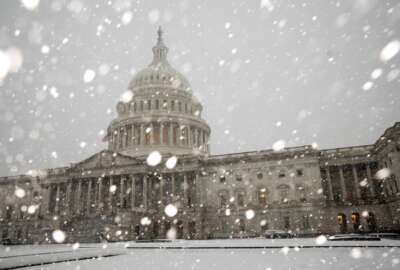USPS sets lower targets for on-time mail, drawing ire from lawmakers
Postmaster General Louis DeJoy defended USPS changes before the Senate Homeland Security and Governmental Affairs Committee, citing declining mail volume.
Lawmakers are pushing back against the next phase of the Postal Service’s 10-year reform plan, amid concerns that its financial condition and ability to deliver mail on time are worsening.
USPS saw a $9.5 billion net loss in fiscal 2024 — far from its “break-even” goal — and is now lowering its targets for how much mail it expects to deliver on time.
USPS told its regulator last week it plans to deliver 87% of two-day first-class mail on time, and 80% of the three-to-five-day first-class mail on time in FY 2025 — down from last year’s goals of 93% and more than 90%, respectively.
The agency already relaxed its service standards three years ago, which slowed the delivery of nearly 40% of first-class mail.
USPS is also pursuing a plan to eliminate some end-of-day trips to collect mail and packages at post offices further away from its regional mail processing hubs.
Postmaster General Louis DeJoy defended these changes before the Senate Homeland Security and Governmental Affairs Committee. USPS, he said, needs to cut costs because of major declines in mail volume.
DeJoy told lawmakers that when he took office in 2020, USPS ran about 55,000 truck trips each day, but the trucks ran about 70% empty.
USPS delivered 59 billion pieces of mail annually about 20 years ago — but is now delivering 12 billion pieces of mail. More than three-quarters of all mail routes, he added, are losing money.
“I try to do one single move on efficiency, and there is no enjoyable answer for anybody here,” DeJoy said in Thursday’s hearing. “I need to get cost out. I don’t believe this is a punitive way. There’s a big, big lift here because nothing’s been done for 20 years, and the impacts are not unfelt. I understand that. It’s scary to many people — I understand that too.”
USPS is seeking an advisory opinion from its regulator on its network Regional Transportation Optimization effort, a plan next year to save billions of dollars by cutting the number of trips its trucks run between mail processing facilities and post offices to transport mail and packages.
The agency expects these adjustments will not only help it squeeze $3 billion of annual overhead costs out of its operations, but enable faster delivery of mail and packages to customers within 50 miles of the agency’s largest regional mail processing plants.
In areas further away from USPS mail processing plants, however, mail and packages would sit a day longer before reaching their destination.
“A two-day may go to three-day. A three-day may go to four-day. A four-day may go to five-day, but nothing’s going beyond five days,” DeJoy said. “We have tens of thousands of trucks running around with nothing in them. That is a big, big reason to make the change.”
Lawmakers and members of the Postal Regulatory Commission say this plan would disproportionately slow rural delivery, but DeJoy is pushing back on those claims.
The RTO plan, he said, would only add an extra day to outbound deliveries — and, if anything, would have a greater impact on urban delivery.
“Significantly more volume gets delivered to people in rural America, in every place, than they actually mail out,” DeJoy said.
Still, members of the committee are not sold on the plan.
Sen. Josh Hawley (R-Mo.) said the RTO plan would disproportionately impact mail delivery in his state, and he would fight to block it.
“I hate this plan and I’m going to do everything I can to kill it,” Hawley told DeJoy. “I’m going to go to the mat on this and I’m going to work with everybody I can across this dais to protect delivery to rural America.”
“If you’re successful, the Postal Service will go down,” DeJoy countered.
Hawley and other members of the committee told DeJoy that said USPS is not addressing mail delays that started once the agency started opening the first of its regional mail processing mega-centers, called Regional Processing and Distribution Centers (RPDCs).
USPS, under its 10-year reform plan, is looking to go from 500 facilities where it processes mail to about 200.
“We have waited, and we have waited, and we have waited for better delivery. I have written you letters like I can’t count, talking about the delivery in the Kansas City area, which is appalling,” Hawley said.
In the Atlanta metro area, only about 35% of first-class mail arrived on time in March. During the worst of these delays, USPS took about 10-12 days to deliver a first-class letter. Sen. Jon Ossoff (D-Ga.) said the region is now seeing about 75-80% on-time delivery, but isn’t close to reaching the kind of turnaround in performance that DeJoy promised him in April.
“You’re not meeting your financial targets. You’re hemorrhaging cash, when you said you’d be making money. Delivery in Georgia has been abysmal this year. You have not recovered as you said you would,” Ossoff said.
DeJoy acknowledged USPS is facing an uphill battle to convince Congress to go along with the rest of his 10-year reform plan. He agreed to pause some of its network modernization plans at least through January 2025, to avoid disruptions during the presidential election and its year-end peak holiday season.
“I think there’s a romance with an organization that long ago lost its ability to do the service that everybody expected, and that’s what the issue is here,” DeJoy said. ”I have calls with congressmen, senators that even understand my plan. They say, ‘Just not in my district, not here.’”
Committee Ranking Member Rand Paul (R-Ky.), who will serve as its chairman in the next session of Congress told DeJoy was “entirely nonsensical” for USPS to convert 190,000 pre-career employees to career positions in recent years.
“Corporations don’t add to their misery by adding and increasing their labor costs,” Paul said.
Career employees get better benefits and higher pay than non-career employees, but DeJoy said USPS needs a stable workforce to keep growing its package business. USPS, he added, has shed about 20,000 employees since he took office, and has cut tens of millions of work hours.
“From the standpoint of service and cost-effectiveness of the labor dollar, I think there is much improvement that we have made, and much improvement that we can get to,” DeJoy said. “I have to make decisions within the environment I have. If I change a collection box time on a blue box, I have the rage of Congress bearing down on me. So, there are trade-offs that one has to make.”
Committee Chairman Gary Peters (D-Mich.) said questions remain about whether USPS is seeing “actual cost reductions” under its 10-year plan.
Congress passed long-awaited reform legislation in 2022 that saved USPS more than $100 billion, by eliminating a requirement to pre-fund retiree health benefits well into the future, and forgiving tens of billions of dollars in payments USPS was supposed to make to its retiree health benefits fund.
Lawmakers also granted $10 billion in emergency funding at the height of the COVID-19 pandemic, and $3 billion in the Inflation Reduction Act to add more electric vehicles to its next-generation delivery fleet.
USPS, in a recent update to its 10-year plan, is asking the Office of Personnel Management to reassess what it pays into the Civil Service Retirement System, the pension system for federal employees who began government service before 1987.
Peters said he recently wrote a letter to the White House calling on OPM to reassess the Postal Service’s pension contributions. The White House did not respond to the letter.
DeJoy said USPS is off course on its break-even plan because the agency incurred $10 billion in retirement costs over three years that it didn’t account for. Those retirement costs, he said, contributed to about 80% of USPS losses this year.
“It is an obligation that will continue to be detrimental to the survival of the organization,” DeJoy said.
In addition, USPS is looking for great flexibility in its pension investment options. USPS, by law, can only invest its retiree and pension funds in low-risk, low-reward Treasury bonds.
“There are things within our investment structure that are killers to us,” DeJoy said.
USPS has about 620,000 current employees and about 710,000 retirees.
Copyright © 2025 Federal News Network. All rights reserved. This website is not intended for users located within the European Economic Area.
Jory Heckman is a reporter at Federal News Network covering U.S. Postal Service, IRS, big data and technology issues.
Follow @jheckmanWFED






